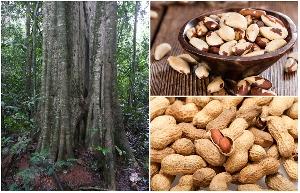Plants exist everywhere, in our homes, gardens, forests, parks, etc. While some just beautify, others are used as medicine, and some as spices.
But in the heart of the Eastern Region, a nature park filled with a variety of plant species, numbering 610, can be found.
The Facility Manager of the Bunso Eco Park, Asare Frimpong, explained that the facility, which started as a Scientific Research Center, has housed these plants for 68 years.
Here are some of the very rare plants located at the Bunso Eco Park in Ghana.
Monkey nuts:
The botanical name for this plant is Lecythis zabucajo. This is a large nut-producing tree usually found in tropical forests.
Aside from Brazil, where the plant is commonly found, it can also be found in countries including Venezuela, Ecuador, and others.
In Ghana, one of the places this plant species can be found is at the Bunso Eco-park in the Eastern Region.
Giving details about the plant, Asare Frimpong, Facility Manager at the Bunso Eco Park, told GhanaWeb “It’s a tree that bears a pot with a lid. Usually, it springs up and during its maturity stage, it turns upside down. When it is ripe to be eaten, through an explosive mechanism, the lid comes off, and the nuts begin to drop. The nuts taste like almonds. The common name is ‘Monkey nuts’. Its season is late July to late October.
“During that period, a pot can contain from 25 to 40 nuts depending on the size of the nut. The bigger the pot, the more nuts; the smaller the pot, the fewer nuts. Within a week, all the nuts fall off, and the pots still hang on the tree for about a year before falling off.”
Brazilian nuts:
Its scientific name is Bertholletia excelsa and is part of the Lecythidaceae family. It’s an edible seed that looks like a hard coconut and produces oil.
“It is three times harder than coconut,” Asare Frimpong explained.
“It has an easy-cutting area. It also has a husk covering it just like a coconut. Just as the palm is our main source of oil, in Southern America, they get their oil from Brazilian nuts. Brazilian nut oil is very good, it’s rich in Omega 3 fatty acids and it helps with cardiac problems so people like them,” he added.
Krobo:
The scientific name for this plant is Balanites Wilsoniana, an evergreen tree with an irregular crown from the caltrop family. It is sometimes called the elephant tree because it is dispersed by elephants.
According to Asare Frimpong, who spoke to GhanaWeb’s People & Places team, “The common name is Krobo, a fragrant plant. Its name was given by the Akans who usually name things by associating them with people who usually use them. The Krobos used to use them years back. During Dipo, they would be performing rites for the little girls who are getting into adulthood, and during that process, they cut these things into 2; it’s white in form so they just scrape it somewhere and then use it as markings for the little girls going to perform the rites.
“When they use them, one week of continuous bath and they’ll still smell good. Krobo powder also, usually they are in small containers, if you want a bigger container of powder to smell good, you just add a little bit of the Krobo powder and mix it.
“In the olden days, our forefathers did not have means of embalming corpses so they usually used this. They grind this and smear it on the body,” he added.
Akuamma:
Its scientific name is Pricalima Nitida. This plant has herbal and medicinal properties. It is usually used in West Africa and is very bitter; all parts of it, from the leaves to the root. It is from the Apocynaceae family and is therapeutic.
It is used to treat diseases including diabetes.
Asare Frimpong, who mans the Eco Park at Bunso where this plant can be found, told GhanaWeb, “Anything nitida in Latin means bitter in English. It is 5 times more bitter than the bitter leaf and if you take it, even the next morning, your mouth will still be bitter. But it is rich in Alkaline and we all know it neutralizes the pH acidic content therefore if you are suffering from indigestion or any other stomach problem, it heals them. It is very hard to take,” he stated.
“They use it to deter kids from sucking on their thumbs or breastfeeding because it’s very bitter. When you want to stop someone from taking alcohol, sometimes you grind some of them (it’s colourless) and then you mix it with the alcohol. When the person takes it, they’ll vomit and that’s it, they’ll never take alcohol again,” he added.
Miracle or Sweet Berry:
Synsepalum dulcificum is its scientific name and locally, it is called ‘Asaa’ in Akan or ‘Tami’ in Ga. It is known for its sweet taste due to miraculin. It is reddish in color and oval in form.
“The reason they are called sweet berry is that they are very sweet but this is the secret behind its sweet taste,” Asare Frimpong told GhanaWeb.
‘When you take about 5 to 10, whatever you take today becomes sweet, even the saliva in your mouth. This one, you are not taking any sugar into your mouth, it is natural. It’s not like the natural sugar we get from mangoes, bananas, etc. It forms a sugar chain in the sweet bud in your mouth and the enzymes come together to tell the nerve to tell you it’s sweet,” he continued.
Watch the full episode below:
This article was originally published in May 2021 by GhanaWeb. It has been reproduced solely for educational purposes.

















